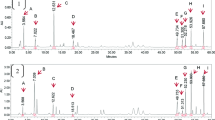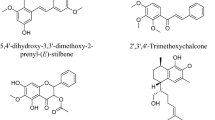Abstract
Propolis is used by corbiculated bees to protect the bee hive; it is mostly used to seal cracks, to reduce or prevent microbial growth and to embalm invaders. Different factors have been reported to influence the chemical composition of propolis, including bee species and the flora surrounding the hive. Nevertheless, the majority of the studies are focused on propolis produced by Apis mellifera, while studies on the chemical composition of propolis produced by stingless bees are still limited. In this investigation, the chemical composition of 27 propolis samples collected in the Yucatan Peninsula from A. mellifera beehives, together with 18 propolis samples from six different species of stingless bees, were analyzed by GC-MS. Results showed that lupeol acetate and β-amyrin were the characteristic triterpenes in propolis samples from A. mellifera, while grandiflorenic acid and its methyl ester were the main metabolites present in samples from stingless bees. Multivariate analyses were used to explore the relationship between bee species and botanical sources on the chemical composition of the propolis samples. Differences in body size and, therefore, foraging abilities, as well as preferences for specific botanical sources among bee species, could explain the observed variation in propolis chemical composition. This is the first report on the composition of propolis samples from the stingless bees Trigona nigra, Scaptotrigona pectoralis, Nannotrigona perilampoides, Plebeia frontalis and Partamona bilineata.





Similar content being viewed by others
Data Availability
Data used in this study are available from the corresponding author upon request.
References
Abou-Shaara HF (2014) The foraging behaviour of honey bees, Apis mellifera: a review. Vet Med (Praha) 59:1–10. https://doi.org/10.17221/7240-VETMED
Adams R (2007) Identification of essential oil components by gas chromatography/mass spectrometry. Texensis, Texas
Andelkovic B, Vujisic L, Vuckovic I, Tesevic V, Vajs V, Godevac D (2017) Metabolomics study of Populus type propolis. J Pharm Biomed Anal 135:217–226. https://doi.org/10.1016/j.jpba.2016.12.003
Araújo ED, Costa M, Chaud-Netto J, Fowler HG (2004) Body size and flight distance in stingless bees (Hymenoptera: Meliponini): inference of flight range and possible ecological implications. Braz J Biol 64:563–568
Araújo KSdS et al (2016) Physicochemical properties and antioxidant capacity of propolis of stingless bees (Meliponinae) and Apis from two regions of Tocantins, Brazil. Acta Amazon 46:61–68. https://doi.org/10.1590/1809-4392201501045
Ayala (1999) Revision de las abejas sin aguijón de México (Hymenoptera: Apidae: Meliponini). Folia Entomol Mex 106:1–123
Babushok VI, Linstrom PJ, Zenkevich IG (2011) Retention indices for frequently reported compounds of plant essential oils. J Phys Chem Ref Data 40:043101. https://doi.org/10.1063/1.3653552
Balekar N, Nakpheng T, Srichana T (2014) Wedelia trilobata L. A phytochemical and pharmacological review. Chiang Mai J Sci 41:590–605
Bankova V (2005) Recent trends and important developments in propolis research. eCAM 2:29–32. https://doi.org/10.1093/ecam/neh059
Bankova V, Popova M, Trusheva B (2014) Propolis volatile compounds: chemical diversity and biological activity: a review. Chem Cent J 8:8. https://doi.org/10.1186/1752-153x-8-28
Boisard S, Huynh THT, Escalante-Erosa F, Hernández-Chavez LI, Peña-Rodríguez LM, Richomme P (2016) Unusual chemical composition of a mexican propolis collected in Quintana Roo, Mexico. J Apic Res 54:350–357
Bracho P, Julio César C, Llanes F (2009) Triterpenos pentacíclios en propóleo. Rev Soc Quím Perú 75:439–452
Caamal-Maldonado A, Armendariz-Yañez I (2002) La sucesión secundaria en los ecosistemas y agroecosistemas tropicales- el henequén (Agave fourcroydes) en el contexto de la diversificación Tropical and Subtropical. Agroecosystems 1:28–32
Campos JF et al (2014) Antimicrobial, antioxidant and cytotoxic activities of propolis from Melipona orbignyi (Hymenoptera, Apidae). Food Chem Toxicol 65:374–380. https://doi.org/10.1016/j.fct.2014.01.008
Carol D, Ngenge T, Emmanuel T, Joseph M, Popova M, Bankova V, Vernyuy T (2017) GC-MS characterization and antiulcer properties of the triterpenoid fraction from Propolis of the North West Region of Cameroon. J Sci Res Rep 15:1–18. https://doi.org/10.9734/JSRR/2017/35377
Chasset T, Habe TT, Ristivojevic P, Morlock GE (2016) Profiling and classification of french propolis by combined multivariate data analysis of planar chromatograms and scanning direct analysis in real time mass spectra. J Chromatogr A 1465:197–204. https://doi.org/10.1016/j.chroma.2016.08.045
Clarke KR, Gorley RN, Somerfield PJ, Warwick RM (2014) Change in marine communities: an approach to statistical analysis and interpretation. PRIMER-E Ltd, Ivybridge
da Silva Mendonça L, Frota VM, Pinto BJF et al (2021) Seasonality in the volatile oil composition of Green Propolis from the Caatinga Biome. Rev Bras Farmacogn 31:497–501. https://doi.org/10.1007/s43450-021-00186-x
Dittmar T, Whitehead K, Minor EC, Koch BP (2007) Tracing terrigenous dissolved organic matter and its photochemical decay in the ocean by using liquid chromatography/mass spectrometry. Mar Chem 107:378–387. https://doi.org/10.1016/j.marchem.2007.04.006
Dutra RP et al (2014) Phenolic acids, hydrolyzable tannins, and antioxidant activity of geopropolis from the stingless bee Melipona fasciculata Smith. J Agric Food Chem 62:2549–2557. https://doi.org/10.1021/jf404875v
Enriquez ME, Yurritia CL, Dardón MJ (2006) Biología y reproducción de abejas nativas sin aguijón. Universidad de San Carlos de Guatemala, Guatemala
Flores JS, Vermont RR (1996) The secretions and exudates of plants used in mayan traditional medicine. J Herbs Spices Med Plants 4:53–59. https://doi.org/10.1300/J044v04n01_07
Herrera-López MG, Rubio-Hernández EI, Leyte-Lugo MA, Schinkovitz A, Richomme P, Calvo-Irabién LM, Peña-Rodríguez LM (2019) Botanical origin of triterpenoids from yucatecan propolis. Phytochem Lett 29:25–29. https://doi.org/10.1016/j.phytol.2018.10.015
Herrera-López MG, Rubio-Hernández EI, Richomme P, Schinkovitz A, Calvo-Irabién LM, Peña Rodríguez LM (2020) Resorcinolic lipids from Yucatecan Propolis. J Braz Chem Soc 31:186–192. https://doi.org/10.21577/0103-5053.20190156
Huang SA, Zhang CP, Wang K, Li GQ, Hu FL (2014) Recent advances in the chemical composition of propolis. Molecules 19:19610–19632. https://doi.org/10.3390/molecules191219610
Huechacona-Ruiz AH, Dupuy JM, Schwartz NB, Powers JS, Reyes-García C, Tun-Dzul F, Hernández-Stefanoni JL (2020) Mapping tree species deciduousness of tropical dry forests combining reflectance, spectral unmixing, and texture data from high-resolution imagery. Forests 11(11):1234. https://doi.org/10.3390/f11111234
Islebe GA, Sánchez-Sánchez O, Valdéz-Hernández M, Weissenberger H (2015) Distribution of vegetation types. In: Islebe G, Calmé S, León-Cortés J, Schmook B (eds) Biodiversity and conservation of the Yucatán Peninsula. Springer, Cham. https://doi.org/10.1007/978-3-319-06529-8_3
Kardar MN, Zhang T, Coxon GD, Watson DG, Fearnley J, Seidel V (2014) Characterisation of triterpenes and new phenolic lipids in cameroonian propolis. Phytochemistry 106:156–163. https://doi.org/10.1016/j.phytochem.2014.07.016
Kuropatnicki AK, Szliszka E, Krol W (2013) Historical aspects of propolis research in modern times. eCAM 2013:964149. https://doi.org/10.1155/2013/964149
Langenheim JH (2003) Plant resins. Timber Press, Portland
Lavinas FC et al (2018) Brazilian stingless bee propolis and geopropolis: promising sources of biologically active compounds. Rev Bras Farmacogn. https://doi.org/10.1016/j.bjp.2018.11.007
Leonhardt SD (2017) Chemical Ecology of Stingless Bees. J Chem Ecol 43:385–402. https://doi.org/10.1007/s10886-017-0837-9
Leonhardt SD, Blüthgen N (2009) A sticky affair: resin collection by Bornean stingless bees. Biotropica 41:730–736. https://doi.org/10.1111/j.1744-7429.2009.00535.x
Maraschin M et al (2016) Metabolic profiling and classification of propolis samples from Southern Brazil: an NMR-based platform coupled with machine learning. J Nat Prod 79:13–23. https://doi.org/10.1021/acs.jnatprod.5b00315
Martins AC, Melo GA, Renner SS (2014) The corbiculate bees arose from new world oil-collecting bees: implications for the origin of pollen baskets. Mol Phylogenet Evol 80:88–94. https://doi.org/10.1016/j.ympev.2014.07.003
Morlock GE, Ristivojevic P, Chernetsova ES (2014) Combined multivariate data analysis of high-performance thin-layer chromatography fingerprints and direct analysis in real time mass spectra for profiling of natural products like propolis. J Chromatogr A 1328:104–112. https://doi.org/10.1016/j.chroma.2013.12.053
Mot AC, Soponar F, Sarbu C (2010) Multivariate analysis of reflectance spectra from propolis: geographical variation in romanian samples. Talanta 81:1010–1015. https://doi.org/10.1016/j.talanta.2010.01.052
Nina N, Quispe C, Jimenez-Aspee F, Theoduloz C, Gimenez A, Schmeda-Hirschmann G (2016) Chemical profiling and antioxidant activity of bolivian propolis. J Sci Food Agric 96:2142–2153. https://doi.org/10.1002/jsfa.7330
Omar R et al (2017) The Chemical characterization of Nigerian propolis samples and their activity against Trypanosoma brucei. Sci Rep 7. https://doi.org/10.1038/s41598-017-01038-2
Ortiz E, Ruiz J, Magaña D, Ramon J (2016) Stingless bee´s honey from Yucatán. Nova Science, New York
Pazin WM, Mônaco LdM, Egea Soares AE, Miguel FG, Berretta AA, Ito AS (2017) Antioxidant activities of three stingless bee propolis and green propolis types. J Apic Res 56:40–49. https://doi.org/10.1080/00218839.2016.1263496
Pino J, Marbot R, Delgado A, Zumárraga C, Sauri E (2006) Volatile constituents of propolis from honey bees and stingless bees from Yucatán. J Essent Oil Res 18:53–56
Quezada-Euán JJG (2005) Biología y uso de las abejas sin aguijón de la Península de Yucatán, México (Hymenoptera: Meliponini). Universidad Autónoma de Yucatán, México
Quezada-Euán JJG (2018) Stingless bees of Mexico. Springer International, Gewerbestrasse
Rodrigues F, Ribeiro MDF (2014) Influence of experience on homing ability of foragers of Melipona mandacaia Smith (Hymenoptera: Apidae: Meliponini). Sociobiology 61. https://doi.org/10.13102/sociobiology.v61i4.523-528
Salatino A, Fernandes-Silva CC, Righi AA, Salatino MLF (2011) Propolis research and the chemistry of plant products. Nat Prod Rep 28:925–936. https://doi.org/10.1039/c0np00072h
Sanpa S, Popova M, Bankova V, Tunkasiri T, Eitssayeam S, Chantawannakul P (2015) Antibacterial compounds from propolis of Tetragonula laeviceps and Tetrigona melanoleuca (Hymenoptera: Apidae) from Thailand. PLoS ONE 10:1–11. https://doi.org/10.1371/journal.pone.0126886
Santos T et al (2017) Melipona mondury produces a geopropolis with antioxidant, antibacterial and antiproliferative activities. An Acad Bras Cienc 89:2247–2259. https://doi.org/10.1590/0001-3765201720160725
Santos Pereira A, Bicalho B, de Aquino Neto FR (2003) Comparison of propolis from Apis mellifera and Tetragonisca angustula Apidologie 34:291–298. https://doi.org/10.1051/apido:2003023
Sawaya ACHF, Cunha IBS, Marcucci MC, de Oliveira Rodrigues RF, Eberlin MN (2006) Brazilian propolis of Tetragonisca angustula and Apis mellifera Apidologie 37:398–407. https://doi.org/10.1051/apido:2006011
Simone-Finstrom M, Spivak M (2010) Propolis and bee health: the natural history and significance of resin use by honey bees. Apidologie 41:295–311. https://doi.org/10.1051/apido/2010016
Toreti VC, Sato HH, Pastore GM, Park YK (2013) Recent progress of propolis for its biological and chemical compositions and its botanical origin. eCAM. https://doi.org/10.1155/2013/697390
Torres-González A, López-Rivera P, Duarte-Lisci G, López-Ramírez A, Correa-Benítez A, Rivero-Cruz JF (2016) Analysis of volatile components from Melipona beecheii geopropolis from Southeast Mexico by headspace solid-phase microextraction. Nat Prod Res 30:237–240. https://doi.org/10.1080/14786419.2015.1043631
Vit P, Pedro S, Roubik D (2013) Pot honey a legacy of stingless bees. Springer, New York
Watson DG et al (2006) Application of principal components analysis to 1H-NMR data obtained from propolis samples of different geographical origin. Phytochem Anal 17:323–331. https://doi.org/10.1002/pca.921
Zamora PC, García GG, Flores JS, Ortiz JJ (2008) Estructura y composición florística de la selva mediana subcaducifolia en el sur del estado de Yucatán, México. Polibotánica 26:39–66
Zellner BdA, Bicchi C, Dugo P, Rubiolo P, Dugo G, Mondello L (2008) Linear retention indices in gas chromatographic analysis: a review. Flavour Fragr J 23:297–314. https://doi.org/10.1002/ffj.1887
Zhao L, Yu M, Sun M, Xue X, Wang T, Cao W, Sun L (2017) Rapid determination of major compounds in the ethanol extract of geopropolis from Malaysian stingless bees, Heterotrigona itama, by UHPLC-Q-TOF/MS and NMR. Molecules 22. https://doi.org/10.3390/molecules22111935
Acknowledgements
The authors wish to thank Gabriel Dzib for technical support in the field; M. G. H. L. thanks Consejo Nacional de Ciencia y Tecnología for Ph D scholarship No. 262149.
Funding
M. G. H. L. received a Ph D scholarship No. 262149 from Consejo Nacional de Ciencia y Tecnología (CONACyT).
Author information
Authors and Affiliations
Contributions
M.G.H., L.M.C and L.M.P., contributed to the study conception and design. Material preparation, data collection and analysis were performed by M.G.H. The first draft of the manuscript was written by M.G.H. and L.M.C, all authors commented on previous versions of the manuscript. All authors read and approved the final manuscript.
Corresponding author
Ethics declarations
The authors have no relevant financial or non-financial interests to disclose.
Competing Interests
The authors declare no competing interests.
Conflict of Interest
The authors declare that they have no potential conflict of interest in relation to the study in this paper.
Additional information
Publisher’s Note
Springer Nature remains neutral with regard to jurisdictional claims in published maps and institutional affiliations.
Supplementary Information
Below is the link to the electronic supplementary material.
ESM 1
(DOCX 46.5 KB)
Rights and permissions
Springer Nature or its licensor (e.g. a society or other partner) holds exclusive rights to this article under a publishing agreement with the author(s) or other rightsholder(s); author self-archiving of the accepted manuscript version of this article is solely governed by the terms of such publishing agreement and applicable law.
About this article
Cite this article
Herrera-López, M.G., Richomme, P., Peña-Rodríguez, L.M. et al. Bee Species, Botanical Sources and the Chemical Composition of Propolis from Yucatan, Mexico. J Chem Ecol 49, 408–417 (2023). https://doi.org/10.1007/s10886-023-01429-y
Received:
Revised:
Accepted:
Published:
Issue Date:
DOI: https://doi.org/10.1007/s10886-023-01429-y




